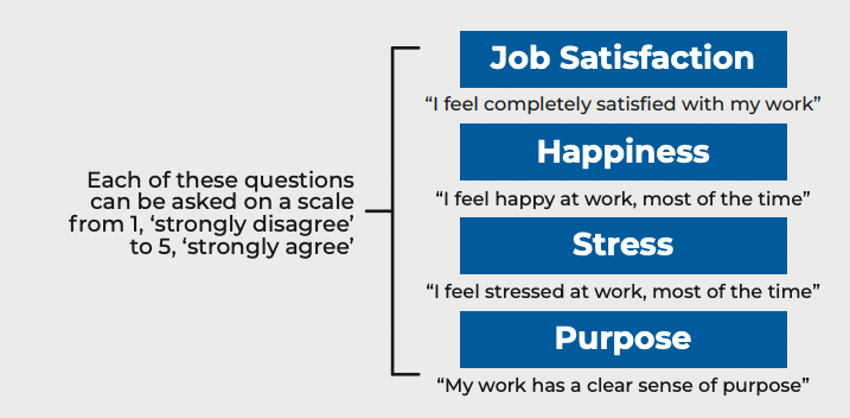03.02.2025 | 8 min read
Measure what you treasure: How (and why) you should track wellbeing at work
Here’s the progress we’ve made on measuring workplace wellbeing so far – and where we’re headed next.Sarah Cunningham and Ben Wealthy
The January chatter is always the same: ‘new year, new me’. Many of us set personal goals – big or small – in the excitement of pinning a fresh calendar to the wall.
But, once back into the familiar rhythm of everyday life, even the best-intentioned resolutions can fall by the wayside. Such changes ought to be for the whole year, not just for January.
Likewise, the UK Government should be thinking about how it can use the levers at its disposal to boost the wellbeing of the whole nation over the long-term. The Employment Rights Bill provides a historic opportunity to put wellbeing at the heart of business, for the benefit of working people, employers and the UK economy.
In our submission to the Business and Trade Committee, the World Wellbeing Movement makes four key recommendations to deliver this vision:
- Recommendation 1: Businesses should be mandated to measure employee wellbeing. Many leading companies are already tracking wellbeing alongside other indicators of their Environmental, Social and Governance (ESG) performance. This would enable businesses and government to monitor progress.
- Recommendation 2: Wellbeing data should be published. Just as government requires larger companies to publish information on gender, ethnicity and disability pay gaps, we propose that wellbeing data is also made available to aid transparency and prompt a systematic focus an organisational level.
- Recommendation 3: Give employees the Right to Switch Off. An Advisory Group should be established to explore and learn from good practice internationally, including countries which have created legislation to protect the ‘Right to Switch Off’.
- Recommendation 4: Make occupational health and safety fit for the modern workplace. Health and wellbeing guidance needs to be reformed to address the causes of workplace stress and promote psychological wellbeing. The UK should look at the approach taken in Australia which requires employers to legally identify, assess and control psychosocial hazards, such as bullying, harassment, and excessive workloads.
Fulfilling recommendations 2 to 4 will not be possible without the first: for organisations to measure what they treasure.
Measure what you treasure
From day one, the World Wellbeing Movement has called for the integration of wellbeing metrics into global standards for evaluating progress of society at large. The same goes for businesses.
Subjective wellbeing is widely regarded as the best way to measure wellbeing in the general population1, since it focuses on how people actually feel about their lives. At its core is a simple, yet powerful question:
On a scale of 0-10, how satisfied are you with your life nowadays?
Extensive academic research, including numerous studies1 by colleagues at our academic partner, the Wellbeing Research Centre at the University of Oxford, has shown that people’s self-reported life satisfaction scores are strong predictors of other aspects of their wellbeing, such as mental health, physical health, and even longevity.
In other words, how satisfied people feel about their lives provides valuable insights into their overall wellbeing.
While many consider this the ‘ultimate’ measure, it does not (and cannot) capture every dimension of wellbeing on its own. The UK’s Office for National Statistics (ONS), and other statistical agencies, including the OECD, complement this life satisfaction question with questions about happiness (positive emotion), stress (negative emotion), and sense of purpose – what ancient scholars might have described as ‘eudaimonic’ wellbeing. Collectively, these four measures are known in the UK as the ONS42.
Our recommendations for measuring employee wellbeing closely mirror the questions used to track wellbeing at a population level, again across four key dimensions:

Combined, these questions provide a holistic view of how employees feel about their work, and are supported by robust academic evidence.
The rationale behind these four questions has been outlined by two of the Oxford academics behind the world’s largest study of employee wellbeing, undertaken alongside Movement founding member, Indeed3 4.
Putting the ‘S’ into ESG reporting
While some large organisations have started to use such questions to measure the wellbeing of their employees – and then take appropriate action, as required – still more companies are yet to recognise the value of workplace wellbeing. (Or, perhaps, they just don’t know where to start.)
One of the World Wellbeing Movement’s most impactful achievements to date has been the provision of insights to S&P Global about the inclusion of a new ‘Trends in Employee Wellbeing’ section within their large-scale Corporate Sustainability Assessment (CSA).
The presence of these questions within the CSA should be a major catalyst for measurement, given the assessment is sent to more than 13,000 organisations on an annual basis5.
But the bar for improvement is low: S&P Global analysis of their 2023 CSA indicates that only 2.2% of firms have employee wellbeing as the core focus in their employee surveys. While just under a third of companies do, at least, measure job satisfaction, only 14% of the companies surveyed asked employees about their happiness at work, and barely one in 10 asked about workers’ levels of stress6.
Further accountability mechanisms are needed if we are to see the majority of employers prioritise and measure employee wellbeing with universally acceptable, science-based measures.
Nevertheless, encouragingly, this hurdle has been cleared before. Only once the International Sustainability Standards Board (ISSB) developed guidance on the environmental aspect of ESG reporting standards did carbon emissions become a byword for an organisation’s green credentials.
While there are a myriad of measures which contribute to the ‘E’ in ESG, carbon emissions figures seem to have cut through as an effective and easy-to-understand metric of headline performance.
We believe that, in order to properly and responsibly fill the ‘S’ in ESG reporting, employee wellbeing could, likewise, become the single most important measure of a much-needed standardised metric.
The Government role
While ESG standards are a significant step towards driving accountability, even the most cynical of shareholders must eventually need to be convinced of the need for change.
That’s where the legislative lever comes in.
The upcoming Employment Rights Bill marks the opportunity for such comprehensive reforms to the foundational rights – and therefore wellbeing – of all employees, at least in the UK.
Although the steps set out so far represent positive progress, the Bill is not yet far-reaching enough. Evidence already shows that our recommendations, if implemented, would significantly benefit individuals, employers and the UK economy.
To us, there’s no better resolution for 2025 than that.
Sarah Cunningham is the Managing Director of the World Wellbeing Movement.
Ben Wealthy is the is the Head of Policy and Public Affairs for the World Wellbeing Movement.
References and further reading
- Layard, R., & Jan-Emmanuel De Neve. (2023). Wellbeing: Science and Policy. Cambridge University Press.
- Personal well-being user guidance – Office for National Statistics. (2018, September 26). www.ons.gov.uk. https://www.ons.gov.uk/peoplepopulationandcommunity/wellbeing/methodologies/personalwellbeingsurveyuserguide
- De Neve, J-E., Ward, G. (2023). Measuring Workplace Wellbeing. University of Oxford Wellbeing Research Centre Working Paper 2303. org/10.5287/ora-exxjkdzym
- Indeed Work Wellbeing Score | Indeed. (2023). indeed.com. https://uk.indeed.com/employers/work-wellbeing
- Corporate Sustainability Assessment. (n.d.). https://portal.s1.spglobal.com/survey/documents/CSA_CorporateSustainabilityAssessment_factsheet.pdf
- Podshadley, E., Laidlaw, J., Moreno, P., & Gupta, R. (2024). Prioritizing employee wellbeing may help stem the tide of rising turnover. spglobal.com. https://www.spglobal.com/esg/insights/featured/special-editorial/prioritizing-employee-wellbeing-may-help-stem-the-tide-of-rising-turnover
Header image: World Wellbeing Movement
